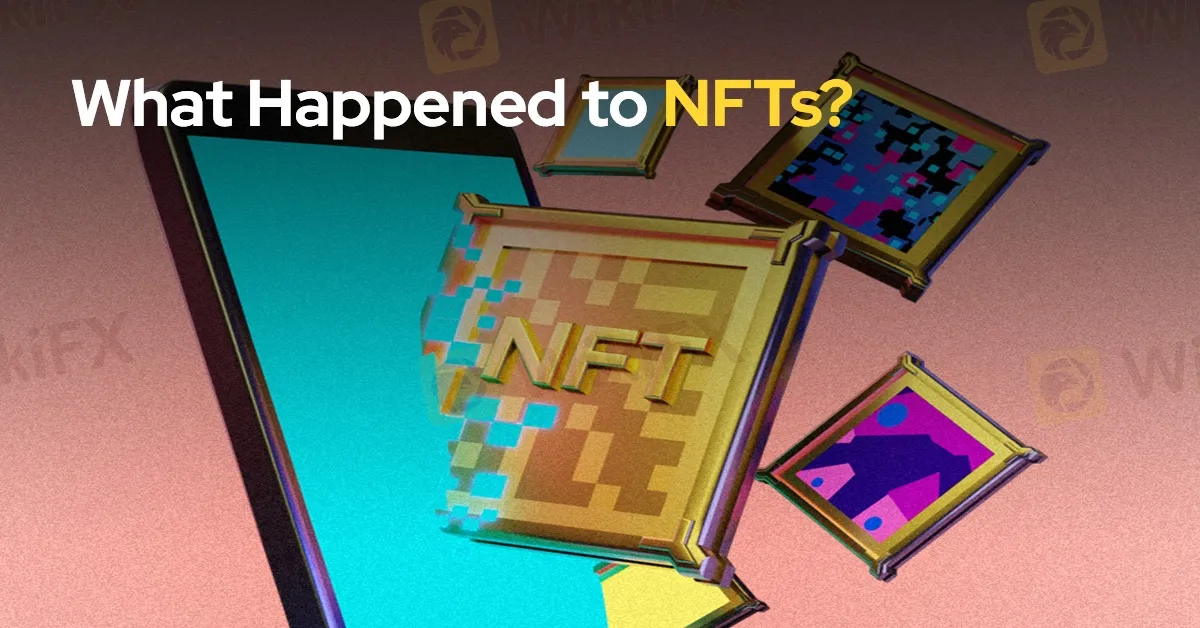简体中文
繁體中文
English
Pусский
日本語
ภาษาไทย
Tiếng Việt
Bahasa Indonesia
Español
हिन्दी
Filippiiniläinen
Français
Deutsch
Português
Türkçe
한국어
العربية
What Happened to NFTs?
Abstract:The NFT market, once booming with speculative investment, has dramatically declined due to economic pressures, systemic failures, and fraud, but shows signs of evolving into a smaller, more stable niche supported by dedicated investors and emerging meme tokens.

Between late 2021 and early 2022, the market for non-fungible tokens (NFTs)—digital property certificates recorded on the blockchain—reached unprecedented heights. Investors, driven by a collective fear of missing out, eagerly pursued unique digital assets, pushing NFT prices to extraordinary levels. This surge of enthusiasm sparked a speculative bubble, leading to record-breaking sales such as Beeples “Everydays: The First 5000 Days,” which fetched $69 million, and CryptoPunk #5822, sold for $23 million.
NFTs allow investors to verify ownership of digital or real-world items, including digital artwork. Each NFT is uniquely identifiable on the blockchain, an immutable ledger, making it irreplaceable. Before NFTs, digital art could circulate freely without clear ownership, but NFTs established a framework for ownership and exclusivity in the digital space.
However, two years after this high, the NFT market has experienced a significant downturn. CryptoSlam reported that in 2023, the trading volume of NFTs dropped by 92%, with average prices down 84% and a 47% decrease in the number of buyers. This sharp decline reflects the changing market environment, particularly as post-pandemic economic pressures and a broader collapse in the cryptocurrency sector led to diminished interest and valuation.

The fall of major crypto platforms, including FTX and the Terra blockchain, further eroded investor confidence, compounding the effects of rising inflation and the shift in spending priorities following the COVID-19 pandemic. According to a report by the cryptocurrency site dappGambl, 95% of more than 73,000 NFT collections now hold no value, leaving approximately 23 million collectors with devalued assets. This loss of value aligns with findings from NFT Scan and CoinMarketCap, highlighting the bubbles burst in a market once dominated by speculation and unregulated investment.
The NFT space also faced setbacks from widespread scams and fraudulent schemes, with hackers and scammers preying on unsuspecting investors. The lack of regulation allowed for the rapid exploitation of the sector, causing substantial losses for many participants. This, coupled with broader systemic issues, discouraged investors and left the NFT market struggling to maintain its peak momentum.
Despite this steep decline, the NFT market remains active, albeit on a much smaller scale. Data from Statista indicates that OpenSea, once the leading NFT marketplace, saw a sharp reduction in trading volume by March 2024, trailing behind newer competitors like Blur. On July 10, OpenSeas daily transaction volume was reported at $1.15 million, significantly lower than its previous monthly average of $15 million, according to DappRadar.
Interestingly, meme tokens—cryptocurrencies rooted in internet memes—have gained traction, providing a window of opportunity in the otherwise challenging digital asset landscape. These tokens have increased in popularity due to their viral appeal, despite the high volatility associated with their value. In 2024, meme coins gained a stronger foothold in the cryptocurrency market, carving out a niche segment that attracts high-risk investors.
Looking ahead, the burst of the NFT bubble does not necessarily signal the end of NFTs as a concept. Rather, the market may evolve into a smaller, more stable niche driven by loyal investors rather than speculative buyers. The NFTs fundamental purpose—assigning uniqueness to digital assets—remains intact, suggesting that the future may see a more selective, steady market rather than a return to its once-frenzied pace.

Disclaimer:
The views in this article only represent the author's personal views, and do not constitute investment advice on this platform. This platform does not guarantee the accuracy, completeness and timeliness of the information in the article, and will not be liable for any loss caused by the use of or reliance on the information in the article.
Read more

First Unfair Trading Case Reported Under South Korea’s Virtual Asset User Protection Act
The Financial Services Commission (FSC) of South Korea has disclosed the first case of unfair trading following the enactment of the Virtual Asset User Protection Act. This law, which took effect in July 2024, aims to regulate the cryptocurrency market and protect investors from fraud and market manipulation.

Upbit Faces Severe Penalties for AML and KYC Violations
Upbit, South Korea’s leading cryptocurrency exchange, faces severe penalties for over 700,000 AML and KYC violations.

Binance’s Bold Move: 12 Trading Pairs Are Getting Delisted
Binance, one of the world’s largest cryptocurrency exchanges, will remove 12 spot trading pairs from its platform on January 17, 2025, at 03:00 (UTC).

BitMEX Fined $100M in U.S. for Anti-Money-Laundering Violations
BitMEX fined $100M for anti-money laundering and KYC violations. The case highlights the U.S. crackdown on crypto platforms ignoring Bank Secrecy Act rules.
WikiFX Broker
Latest News
How Long Can the Dollar Remain Strong?
Forex Price Trend Prediction! | Come be a New Year Price Winner!
HFM NY Special Offer!
How a Promised RM1.4 Million Return Turned into a Costly Scam
Cinkciarz.pl Under Fire: Frozen Accounts, Missing Funds
First Unfair Trading Case Reported Under South Korea’s Virtual Asset User Protection Act
“Predict and Win” Big Rewards! Join the Contest Now
"Jumped Deposit Scam": New Wave of Financial Fraud in India
South Korean President Yoon Suk Yeol's Arrest Shakes Markets
Titanium Capital LLC Ponzi Scheme: Henry Abdo Admits Fraud, Impacting Over 200 Investors
Currency Calculator






